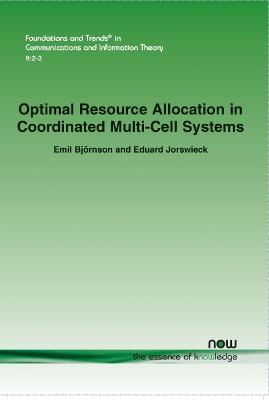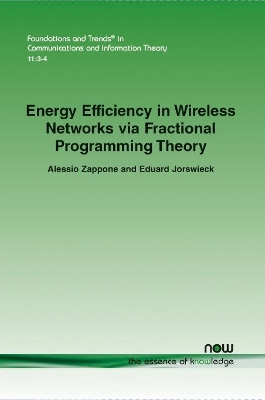Foundations and Trends (R) in Communications and Information Theory
3 total works
Majorization and Matrix Monotone Functions in Wireless Communications
by Eduard Jorswieck and Holger Boche
Published 1 January 2007
This book reviews the basic definitions of Majorization Theory and Matrix-Monotone Functions, describing their concepts clearly with many illustrative examples. In addition to this tutorial, new results are presented with respect to Schur-convex functions and regarding the properties of matrix-monotone functions.
The approach taken by the authors provides a valuable overview of the basic techniques for readers who are new to the subject. They then proceed to show in separate chapters the cutting edge applications of the two basic theories in wireless communications.
Majorization Theory and Matrix-Monotone Functions in Wireless Communications is an invaluable resource for students, researchers and practitioners involved in the state-of-the-art design of wireless communication systems.
The approach taken by the authors provides a valuable overview of the basic techniques for readers who are new to the subject. They then proceed to show in separate chapters the cutting edge applications of the two basic theories in wireless communications.
Majorization Theory and Matrix-Monotone Functions in Wireless Communications is an invaluable resource for students, researchers and practitioners involved in the state-of-the-art design of wireless communication systems.
Optimal Resource Allocation in Coordinated Multi-Cell Systems
by Emil Bjoernson and Eduard Jorswieck
Published 28 January 2013
The use of multiple antennas at base stations is a key component in the design of cellular communication systems that can meet high capacity demands. The downlink transmission from base stations to users is particularly limiting, because many applications primarily create downlink traffic. The user devices should also be inexpensive and energy-efficient, thus only simple reception algorithms are feasible. Under ideal conditions, the gain of employing multiple antennas is well-recognized: the data throughput increases linearly with the number of transmit antennas if the spatial dimension is utilized to serve many users in parallel.
The practical performance of multi-cell systems is however limited by a variety of non-idealities, such as insufficient channel knowledge, high computational complexity, heterogeneous user conditions, limited backhaul capacity, transceiver impairments, and the constrained level of coordination between base stations.
Optimal Resource Allocation in Coordinated Multi-Cell Systems presents in a tutorial manner a general framework for modeling different multi-cell scenarios, including clustered joint transmission, coordinated beamforming, interference channels, cognitive radio, and spectrum sharing between operators. The framework enables joint analysis and insights that are both scenario independent and dependent. A comprehensive characterization of resource allocation problem categories is also given, along with the corresponding numerical signal processing algorithms. This provides a pragmatic foundation for resource allocation where the system utility metric can be selected to achieve practical feasibility. The tutorial also derives and parameterizes the structure of the optimal resource allocation, in terms of beamforming vectors and optimal operating points.
Optimal Resource Allocation in Coordinated Multi-Cell Systems provides a solid grounding and understanding for optimization of practical multi-cell systems and will be of interest to all researchers and engineers working on the practical design of such systems. The Matlab code is available online for some of the examples and algorithms in this tutorial.
The practical performance of multi-cell systems is however limited by a variety of non-idealities, such as insufficient channel knowledge, high computational complexity, heterogeneous user conditions, limited backhaul capacity, transceiver impairments, and the constrained level of coordination between base stations.
Optimal Resource Allocation in Coordinated Multi-Cell Systems presents in a tutorial manner a general framework for modeling different multi-cell scenarios, including clustered joint transmission, coordinated beamforming, interference channels, cognitive radio, and spectrum sharing between operators. The framework enables joint analysis and insights that are both scenario independent and dependent. A comprehensive characterization of resource allocation problem categories is also given, along with the corresponding numerical signal processing algorithms. This provides a pragmatic foundation for resource allocation where the system utility metric can be selected to achieve practical feasibility. The tutorial also derives and parameterizes the structure of the optimal resource allocation, in terms of beamforming vectors and optimal operating points.
Optimal Resource Allocation in Coordinated Multi-Cell Systems provides a solid grounding and understanding for optimization of practical multi-cell systems and will be of interest to all researchers and engineers working on the practical design of such systems. The Matlab code is available online for some of the examples and algorithms in this tutorial.
Energy Efficiency in Wireless Networks via Fractional Programming Theory
by Alessio Zappone and Eduard Jorswieck
Published 11 June 2015
The modern world of ubiquitous communication devices has fueled recent research into the need to find technical solutions to address energy consumption concerns raised by various stakeholders. These include:
- The exponential increase of connected devices that wireless communications have been experiencing poses serious sustainable growth concerns.
- The rapid expansion of wireless networks causes environmental concerns.
- Economic concerns drive the development of novel energy-efficient ICT.
This monograph focuses on energy-efficient wireless network design, including resource allocation, scheduling, precoding, relaying, and decoding. Starting from simple point-to-point (P2P) systems and then gradually moving towards more complex interference networks, the energy efficiency is defined and its properties characterized. The authors show how the energy efficiency is naturally defined by fractional functions, thus establishing that a key role in the modeling, analysis, and optimization of energy efficiency is played by fractional programming; a branch of optimization theory specifically concerned with the properties and optimization of fractional functions.
The monograph introduces fractional programming theory, and illustrates how it can be used to formulate and handle energy efficiency optimization problems. It provides a comprehensive introduction to the theoretical and practical aspects of these problems and describes the solutions offered with this technique. It will be of use to all researchers and engineers working on modern communication systems.


